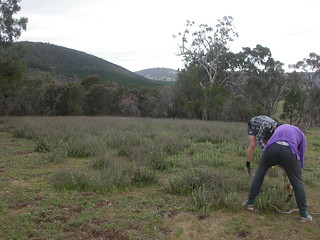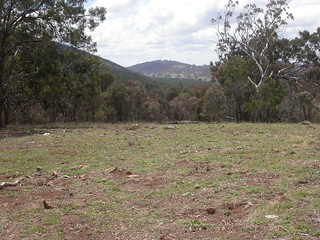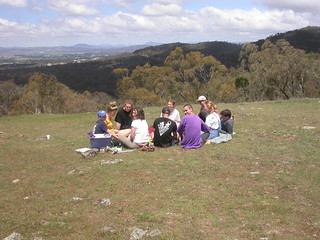
Proud weeder Tanja posing in front of a horehound pile.
Few things are more satisfying than the hand weeding horehound – you really see what you’ve done!
On Sunday 29 October, ten ANU Intrepid students and a couple of Friends of Mt Majura hand removed horehound at an old sheep camp located on the beautiful ridge between Mt Majura and Mt Ainslie. It was a cool and overcast morning perfectly suited for the work.

Horehound infested stock camp…

…and 3 hours and a banana cake later.

A well-deserved picnic after work.
In 3 hours, the crew cleared several hundred square meters and concluded the successful weeding morning with a lovely picnic.
There is still horehound left which we hope to chip away over time.
You can help! Go for a pleasant walk (click on this map to view the location and access), take a little mattock and a pair of gloves with you, choose your personal horehound site and hack for half an hour – you will be amazed how much you can clear in a short time. Add the removed horehounds to the large piles and be proud of yourself.
We can provide short-handled light mattocks. Please contact secretary@majura.org if you are interested.
Horehound, Marrubium vulgare L. is native to Europe, the Middle East, and the Mediterranean region including North Africa. It was introduced to Australia in the 19th century as a medicinal herb and became a weed of native grasslands and grassy woodlands where it was introduced with settlers’ livestock.
Horehound is now widespread throughout Australia and is declared under noxious weeds legislation in several Australian states and regions. It occupies disturbed or overgrazed ground and is common on sheep camps, around rabbit warrens and in waste places.
Horehound is favoured by grazing because of its high alkaloid content which makes it unpalatable to livestock and other herbivores. Once established, the perennial weed persists in native vegetation preventing desirable species from growing. Seeds are primarily dispersed by stock and other furred animals as the fruit or burr readily attaches to fur. Water is also an effective dispersal agent, and horses are known to pass the seeds, after ingestion, in a viable condition.
Over the past 13 years FoMM volunteered 1000 of hours hand-weeding a number of large sites in the Mt Majura nature reserve that were infested with horehound. The old sheep camp located on a beautiful ridge between Mt Majura and Mt Ainslie is the last vast horehound site in the reserve (there are some smaller sites often around trees that indicate old stock rest sites or rabbit warrens).


